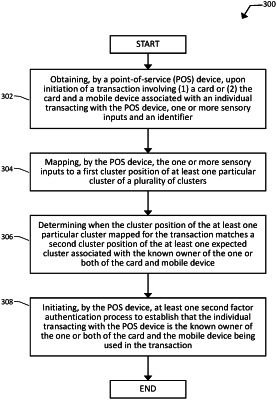| CPC G06Q 20/4016 (2013.01) [G06Q 20/204 (2013.01); G06Q 20/341 (2013.01); G06Q 20/409 (2013.01)] | 20 Claims |

|
1. One or more computer-readable media containing and/or configured to execute computer-readable instructions, the computer-readable instructions comprising instructions that, when executed by one or more processors, cause the one or more processors to perform a method comprising:
obtaining, by a point-of-service (POS) device, upon initiation of a transaction involving (1) a card or (2) the card and a mobile device associated with an individual transacting with the POS device:
(i) one or more sensory inputs associated with a use of the one or both of the card and the mobile device for the transaction, the one or more sensory inputs comprising one or more card-acquired sensory inputs received from one or more sensors on the card;
wherein the one or more sensory inputs comprise sensory feedback measured by the one or more sensors based on usage of the card for the transaction; and
wherein the one or more sensory inputs are saved into the card as a feature set and transmitted to the POS device upon the initiation of the transaction; and
(ii) an identifier (1) associated with an owner of the one or both of the card and the mobile device and (2) used to determine whether the one or more sensory inputs are consistent with prior transaction behavior of the owner;
transforming, using a machine learning technique, the one or more sensory inputs associated with the transaction into feature information having a format configured for comparison against historical feature data established by applying the machine learning technique to historical card-usage information of the owner;
performing sensory input mapping of the feature information to a cluster position of at least one particular cluster of a plurality of clusters, wherein the plurality of clusters defines sets of learned features regarding prior known interactions of owners of cards with POS devices;
performing a fraud determination based on mapping of the cluster position of the at least one particular cluster to at least one expected cluster associated with the known owner of the one or both of the card and mobile device; and
approving the transaction based on the fraud determination.
|